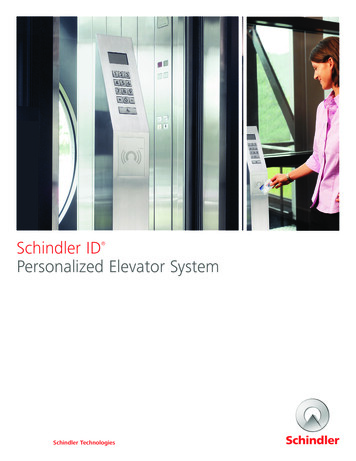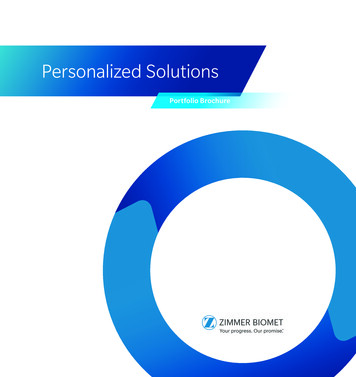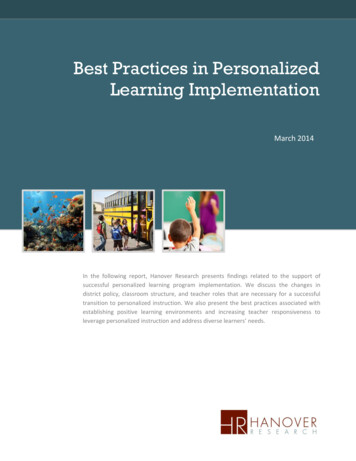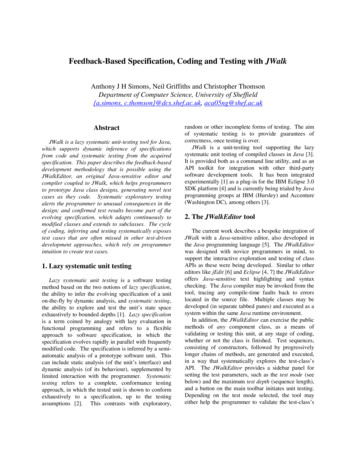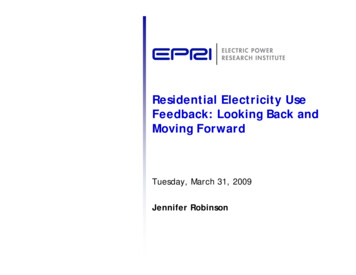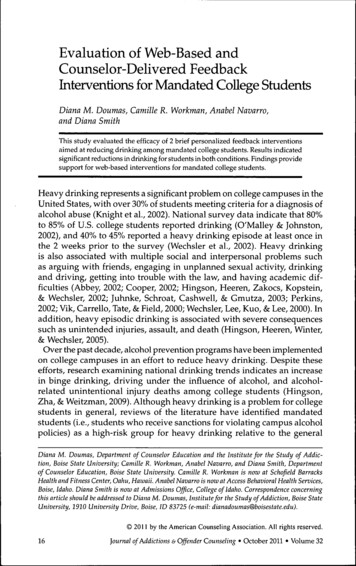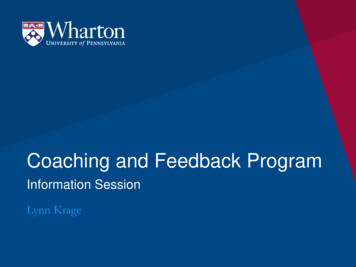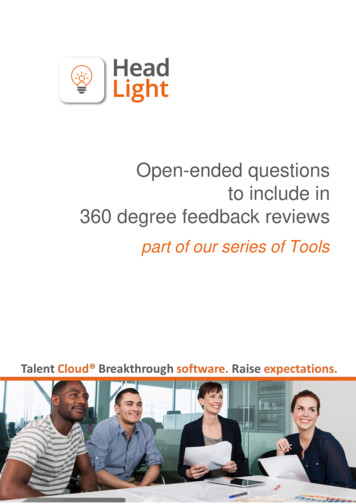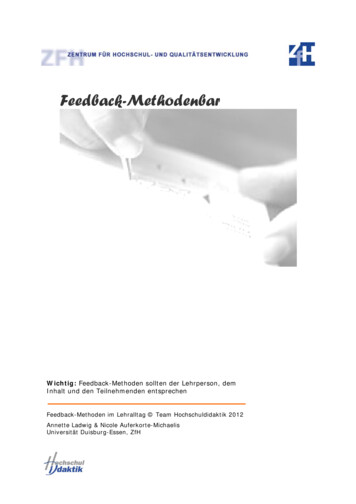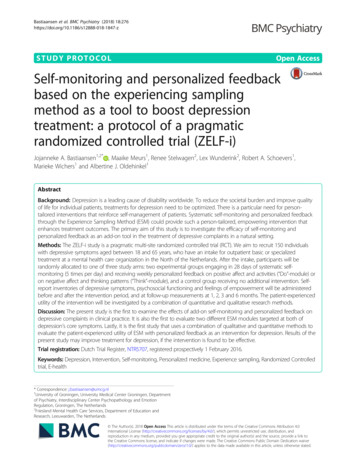
Transcription
Bastiaansen et al. BMC Psychiatry (2018) DY PROTOCOLOpen AccessSelf-monitoring and personalized feedbackbased on the experiencing samplingmethod as a tool to boost depressiontreatment: a protocol of a pragmaticrandomized controlled trial (ZELF-i)Jojanneke A. Bastiaansen1,2* , Maaike Meurs1, Renee Stelwagen2, Lex Wunderink2, Robert A. Schoevers1,Marieke Wichers1 and Albertine J. Oldehinkel1AbstractBackground: Depression is a leading cause of disability worldwide. To reduce the societal burden and improve qualityof life for individual patients, treatments for depression need to be optimized. There is a particular need for persontailored interventions that reinforce self-management of patients. Systematic self-monitoring and personalized feedbackthrough the Experience Sampling Method (ESM) could provide such a person-tailored, empowering intervention thatenhances treatment outcomes. The primary aim of this study is to investigate the efficacy of self-monitoring andpersonalized feedback as an add-on tool in the treatment of depressive complaints in a natural setting.Methods: The ZELF-i study is a pragmatic multi-site randomized controlled trial (RCT). We aim to recruit 150 individualswith depressive symptoms aged between 18 and 65 years, who have an intake for outpatient basic or specializedtreatment at a mental health care organization in the North of the Netherlands. After the intake, participants will berandomly allocated to one of three study arms: two experimental groups engaging in 28 days of systematic selfmonitoring (5 times per day) and receiving weekly personalized feedback on positive affect and activities (“Do”-module) oron negative affect and thinking patterns (“Think”-module), and a control group receiving no additional intervention. Selfreport inventories of depressive symptoms, psychosocial functioning and feelings of empowerment will be administeredbefore and after the intervention period, and at follow-up measurements at 1, 2, 3 and 6 months. The patient-experiencedutility of the intervention will be investigated by a combination of quantitative and qualitative research methods.Discussion: The present study is the first to examine the effects of add-on self-monitoring and personalized feedback ondepressive complaints in clinical practice. It is also the first to evaluate two different ESM modules targeted at both ofdepression’s core symptoms. Lastly, it is the first study that uses a combination of qualitative and quantitative methods toevaluate the patient-experienced utility of ESM with personalized feedback as an intervention for depression. Results of thepresent study may improve treatment for depression, if the intervention is found to be effective.Trial registration: Dutch Trial Register, NTR5707, registered prospectively 1 February 2016.Keywords: Depression, Intervention, Self-monitoring, Personalized medicine, Experience sampling, Randomized Controlledtrial, E-health* Correspondence: j.bastiaansen@umcg.nl1University of Groningen, University Medical Center Groningen, Departmentof Psychiatry, Interdisciplinary Center Psychopathology and EmotionRegulation, Groningen, The Netherlands2Friesland Mental Health Care Services, Department of Education andResearch, Leeuwarden, The Netherlands The Author(s). 2018 Open Access This article is distributed under the terms of the Creative Commons Attribution 4.0International License (http://creativecommons.org/licenses/by/4.0/), which permits unrestricted use, distribution, andreproduction in any medium, provided you give appropriate credit to the original author(s) and the source, provide a link tothe Creative Commons license, and indicate if changes were made. The Creative Commons Public Domain Dedication o/1.0/) applies to the data made available in this article, unless otherwise stated.
Bastiaansen et al. BMC Psychiatry (2018) 18:276BackgroundAccording to the World Health Organization, the leading cause of disability worldwide is depression [1], acommon mental disorder that is characterized by twocore symptoms: depressed mood and decreased interestor pleasure in activities [2]. Optimizing treatments fordepression will reduce the societal burden and improvequality of life for individual patients. There is a particular need for cost-effective, personalized interventionsthat support the mental health care sector and reinforceself-management of patients (e.g., [3, 4]). Systematicself-monitoring and personalized feedback on contextualized patterns of affect through the Experience Sampling Method (ESM) could provide such anempowering, low-cost intervention.With ESM, a patient gathers a multitude of prospectivein-the-moment daily life assessments on affect, behavior,and context [5, 6]. Through aggregation of these systematically collected data, ESM can generate information thatgoes beyond what has been explicitly listed by the patient.Moreover, sophisticated analyses such as time-series analyses can determine the temporality of effects within a specific person, for instance, whether increased positive affect(PA) precedes or follows an increase in physical activity.ESM has generated important scientific insights in daily lifeemotional dynamics in depressed patients (for reviews see[7, 8]). Even more importantly, ESM also has great potentialfor clinical practice and the individual patient, because it allows personalized feedback (e.g., [9–11]. Small-scaleproof-of-principle studies have underlined the potential ofthis approach for the individual patient (e.g., [10, 12, 13]).Kauer and colleagues [14] investigated the efficacy ofself-monitoring and feedback on mood, stress, and daily activities as a therapeutic tool for adolescents with emotionalor mental health issues in a larger study (n 114). Theyfound that, compared to the control group (which onlymonitored daily activities), emotional self-awareness increased more in the intervention group, which in turndecreased depressive symptoms. More recently, a pioneerrandomized controlled trial (RCT) established the efficacyof ESM as a therapeutic tool for patients with depression(n 102, [15]). That is, add-on ESM-derived personalizedfeedback on PA and activities resulted in a significantly andclinically relevant stronger decrease in depressive symptoms compared to pharmacological treatment alone. Whilepromising, the ESM intervention was evaluated in theabsence of psychotherapy, which is a common part of depression treatment, and had an extensive face-to-facecomponent itself. Therefore, it is not yet known whetherESM as a self-management tool could have added positiveeffects to treatments in regular clinical practice. In addition,data acquisition as well as data analysis for the personalizedfeedback reports were a laborious exercise, hampering usein clinical practice.Page 2 of 11We will take the necessary steps to move ESM-derivedpersonalized feedback closer towards implementation as atherapeutic tool for depression in this study, which is namedthe ZELF-i project to emphasize the self-management aspect of our approach (self zelf in Dutch, i stands for intervention). First, we will optimize the ESM intervention forclinical practice by making it easily accessible on patients’own smartphones and by reducing personnel investmentthrough automatized personalized analyses and digital feedback reports. Second, we will reexamine the previously reported efficacy of ESM-derived personalized feedback on PAand activities (ESM “Do-module”) in an RCT embedded ina naturalistic clinical context. Third, we will examine the efficacy of an alternative ESM module focused on negativeaffect (NA) and thinking patterns (ESM “Think-module”).Until now, there have only been studies with one specificmodule or a general set of items. Therefore, it is unknownwhether the form (systematic self-monitoring) or the content of an ESM module is relevant. Our two ESM modulesare both conceivably beneficial, as they link up with the twomain angles of psychotherapy for depression: behavioral activation through positive reinforcement of activities, andcognitive therapy aimed at helping individuals recognize andreplace negative thinking patterns [16].Self-monitoring and personalized feedback throughESM is a potential improvement for depressed patients forseveral reasons. First, previous studies suggest clear healthbenefits in terms of a decrease in depressive symptoms[14, 15]. Second, in contrast to pharmacotherapy, theintervention mobilizes patients as active agents in theirprocess to recovery, as evidenced by increases in feelingsof empowerment [17]. Third, the intervention supportspatients outside the clinician’s office, in their daily lives,which is where changes should occur. Fourth,person-tailored approaches should become the new focusin mental health care according to national and international directives (e.g., [4]) and patient organizations(e.g., Landelijk Platform GGZ). The intervention meetsthis need by providing personalized feedback on relevantaspects of daily life such as diurnal mood fluctuations,affective reactivity to social and physical activities, and theactivation of negative thinking patterns in response to sadmood. Fifth, patients can start directly after intake, makingthe most out of the commonly long wait list period atmental health organizations [18]. Considering that patients usually start seeking professional care out of a senseof urgency, we hope that it will be satisfactory to themthat they will be able to start working on their problemsdirectly, without a period of passive waiting. Sixth, bybringing their feedback reports in at the start of the treatment, patients could commence specialized mental healthcare programs with a kick-start. By already having monitored their thoughts and feelings in relation to their activities for a couple of weeks, they are likely to have acquired
Bastiaansen et al. BMC Psychiatry (2018) 18:276a better insight in the processes involved in their depressive symptoms and day-to-day functioning than patientswho did not partake in self-monitoring. Seventh, no costlyequipment is required, only a working smartphone, whichmeans the intervention could potentially reach many patients seeking care. In fact, interest among psychiatric outpatients in using smartphones to monitor their mentalhealth is high [19].According to guidelines for the development ofevidence-based directives, two independently performedhigh-quality RCTs of substantive size provide the highestlevel of proof for the efficacy of an intervention [20].Thus, the proposed RCT could provide more definitiveanswers regarding the efficacy of ESM as a therapeutictool for depression. While a reduction in depressivesymptomatology is important, we believe ‘health’ goesbeyond the traditional definition as the absence of illness. ESM-derived personalized feedback could assist patients in actively trying to gain more control over theirown psychological problems and enhance their functioning as evidenced by increases in feelings of empowerment [17] and increased engagement in social activities[21]. These functional outcomes are at least as relevantas clinical outcomes, as for many patients the essence ofrecovery is to rise above the presumed limitations associated with mental illness [22]. In fact, more and morevoices are calling for a reformulation of ‘health’ into theability to adapt and to self-manage in the face of social,physical and emotional challenges (e.g., [23]). Therefore,we will examine the impact of the ESM intervention notonly on depressive symptoms, but also on measures offunctioning and empowerment.When evaluating an intervention not only the efficacyon a group level is important, but the perspective of individual patients also needs to be taken into account [24].Qualitative methods in which the experiences and opinions of patients are at the center, should be an essentialcomponent of health care research [25]. Qualitative research based on interviews with patients has shown thatan active attitude towards rehabilitation and structured attention to oneself are important themes for individualswith depression [26, 27]. ESM with personalized feedbackcould meet these wishes, but there has been virtually noresearch on patient experiences with such an intervention,except for a personal case study by Peter Groot [10]. Hedescribes how self-monitoring of his mood helped him inhis recovery process as follows (p. 354): “I now look at myown mood swings in a different way. I can accept moreeasily the gloomy periods I still have once in a while; theyare briefer, I get through them more easily, and I think theyoccur less frequently than in the past. I feel better ‘protected’ and more ‘empowered’ against the vulnerability withwhich I have apparently been cursed.” It is not knownwhether these experiences generalize to other individuals.Page 3 of 11Therefore, a secondary aim of the ZELF-i project is toevaluate the patient-experienced utility of ESM with personalized feedback through patient interviews.MethodsZELF-i is a multi-site trial designed according to theprinciples of a pragmatic RCT to allow evaluation of theintervention in real-life care facilities. Details are described below according to the SPIRIT guidelines [28].The study was approved by the Medical Ethical Committee of the University Medical Center Groningen (no.2015/530). The trial has been registered prospectively inthe Dutch Trial Register (Nederlands Trial Register,NTR5707, http://www.trialregister.nl) at 1 February2016.ParticipantsWe will recruit 150 male and female adult patients referred for depressive complaints to general or specializedoutpatient teams at mental health care organizations inthe North of the Netherlands. Participants will be recruited within the research network of mental health institutions in the North of The Netherlands, the Rob GielResearch Center (https://www.rgoc.nl), which covers acatchment area of over 4 million inhabitants. Eligibilitycriteria are broad to include typical patients. Inclusioncriteria are: a) indication for depression treatment by themental health care professional (hereafter named: practitioner); b) age between 18 and 65 years; and c) writteninformed consent. Exclusion criteria are (based on practitioners’ appraisals): a) crisis intervention warranted(i.e., in the case of acute suicidality); b) presence ofpsychotic or manic symptoms; and c) incapability of following research procedures due to inadequate Dutchlanguage proficiency, significant auditory or visual impairments or mental retardation. Patients will be enrolled in regular treatment upon availability, that is, thestart of regular treatment will not be postponed untilparticipation in ZELF-i finishes. The ZELF-i interventionis intended as an add-on tool at the start of care as usualand thus circumstances are otherwise kept as ‘natural’ aspossible. Participants will receive travel reimbursementsand an additional 10 if they used the data bundle oftheir own smartphone to participate in the intervention.ProcedureRecruitmentAn overview of the study design is presented in Fig. 1.Individuals scheduled for intake at one of the participating mental health care teams will receive an informationletter about ZELF-i and a contact consent form togetherwith their intake invitation. Through the information letter, participants will be made aware of the procedurethat, at the end of the intake, the practitioner will
Bastiaansen et al. BMC Psychiatry (2018) 18:276Page 4 of 11Fig. 1 Overview of the design of the randomized controlled trial. ESM Experience Sampling Method. * The interview is optional and will takeplace before the 2 month follow-up. ** The time interval between the start date of the participation in ZELF-i and the start date of regulartreatment varies between participantsdiscuss the possibility to participate in ZELF-i with themif a) depression treatment is indicated, and b) the practitioner deems ZELF-i suited for the patient. Participantswill be made aware that participation is voluntary andrefusal to participate will not affect their treatment.Patients decide independently whether they are interestedin the research and want to be contacted by the researchteam by sending back the consent form or bringing it tothe intake at the mental health care institution. It isimportant that eligible participants are enrolled in the studyshortly after the intake, because the intervention (28 days)is designed to support participants early on and bridge potential waiting periods between the intake and the start ofthe indicated depression treatment in a constructive way.Therefore, eligible participants will be contacted by a research assistant preferably within a few days after the intaketo answer any questions and schedule an appointment forthe introduction session of the intervention study.Introduction session and baseline measurementThe introduction session will take place at the mentalhealth care organization. At the start of the introductionsession, participants will have another opportunity toask questions about the study procedures. If everythingis clear, they will be asked to provide written informedconsent. After the informed consent procedure, participants will be randomly allocated to the control group orone of two ESM intervention groups. Then, detailed instructions and practice runs for the ESM modules follow,depending on the allocated treatment condition. Finally,all participants will fill out questionnaires assessingcharacteristics at baseline, depressive symptomatology,functioning, empowerment, and questionnaires necessaryfor cost-effectiveness analyses (see Study Parameterssection).RandomizationParticipants will be randomly allocated to the control groupor one of two ESM intervention groups (“Do-module” and“Think-module”). Randomization (allocation ratio 1:1:1)will be stratified per treatment location according to theduration of antidepressant pharmacotherapy (new/switchvs. maintenance, i.e., receiving antidepressant or mood stabilizing medication for less vs. longer than 8 weeks prior tostudy entry), and current psychotherapy (yes or no). Forthese different strata, separate blocks with an allocation sequence of six with an equal condition distribution will becreated using an online randomization tool (https://www.random.org/lists). Thus, each of the three conditionswill be present twice in a block of six. The allocation will beimplemented by using sequentially numbered sealed envelopes (i.e., one pile of envelopes for each stratum). The allocation will be done during the introduction session, byteam members who do not have access to the allocation sequence. Participants and research assistants are obviouslynot blind to treatment. Practitioners are not blind to treatment per se; participants decide themselves whether theywant to discuss their feedback reports with their (future)therapist.Intervention periodThe ESM measurements consist of brief questionnaireson the smartphone via a link to a secured website forroutine outcome monitoring (RoQua, https://www.roqua.nl). Participants who do not have a smartphone oftheir own will be provided with one for use during the
Bastiaansen et al. BMC Psychiatry (2018) 18:276intervention period. Participants will be instructed howto fill out the ESM measurements using their smartphone and how to interpret the questions. Participantswill fill out ESM measurements five times a day duringthe course of their daily lives for 28 days. The measurements will occur at set points in time during wakinghours (i.e., every three hours during the day, Fig. 2),which will be programmed to optimally fit the participant’s usual daily rhythm.Participants will be asked to complete their reports preferably immediately after they receive a text message withthe link to the questionnaires. To minimize memory distortion, the link expires after 30 min. Participants w
self-monitoring and feedback on mood, stress, and daily ac-tivities as a therapeutic tool for adolescents with emotional or mental health issues in a larger study ( n 114). They found that, compared to the control group (which only monitored daily activities), emotional self-awareness
